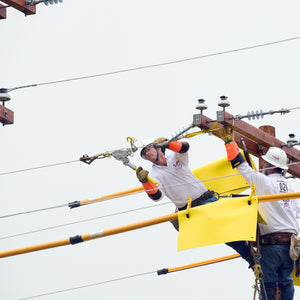Lineman Disaster Recovery Stories: Hurricane Isaac

When hurricane season hits in the US, it’s almost guaranteed that some part of the country will face widespread loss of electricity. Hurricanes bring heavy sustained winds from 74 mph to over 150 mph as well as heavy rains and extensive flooding that can damage power grids and cut off power to millions of people. The biggest questions during hurricane season are where it’s going to happen and how many people will be affected. The 2019 hurricane season kicked off with Barry, a Category 1 hurricane that made landfall in Louisiana.
A large number of severe hurricanes have struck the east coast and gulf states in recent years: Hurricanes Florence, Harvey, Maria, Matthew, and Sandy, are just a few of the memorable storms in recent years. With the amount of damage being caused by powerful storms, the electrical infrastructure in the Eastern US has been put under a lot of stress. But when hurricanes and other natural disasters bring down the electrical grid and millions of people are without power, America’s linemen are some of the first to respond.
When most people think of emergency services and first responders, electrical linemen aren’t necessarily the first people that come to mind. The fact is many other first responders rely on a quick response from linemen to restore power in local hospitals, police stations, and fire stations when storms knock out the electricity. The hard work of these dedicated linemen is one of the most important parts of every disaster recovery.
When hurricanes and other natural disasters strike, there is a huge amount of work that must be done in as little time as possible. The high demand caused by these destructive storms can stretch resources thin at local electrical co-ops. In order to restore power in the affected areas quickly, linemen travel from around the country to provide the necessary manpower.
In this series of blog entries, we’ll be looking at the stories of four linemen from around the country who have responded to a variety of natural disasters. The first story comes from DJ, an electrical lineman from Virginia.
DJ—Central Virginia Electrical Co-op
In 2012, Tropical Storm Isaac developed into a Category 1 Hurricane as it moved from the Caribbean Islands toward US states in the Gulf of Mexico. As it approached land, the outer edges of the storm brought rain and winds to Florida, Alabama, Arkansas, Mississippi, and Louisiana. 60,000 residents evacuated low-lying coastal areas of Louisiana, and shortly after, Isaac made two landfalls in the state.
As Hurricane Isaac moved inland, it pounded Louisiana with 80-mile per hour sustained winds. In some places along the coast, the storm surge reached heights near 10 feet, and rainfall reached nearly two feet at its most intense. Rivers and low-lying areas flooded, leaving huge areas of land underwater. In total, Hurricane Isaac caused an estimated $3.44 billion worth of damage and disrupted electrical power service to more than 900,000 homes and businesses.
Many linemen from the surrounding areas travelled to Louisiana and the other affected states in the aftermath of Hurricane Isaac. With nearly half of Louisiana’s energy users without power, the demand to restore the electrical grid in the state was tremendous. DJ Noble, a lineman for the Central Virginia Electrical Co-op, was among the linemen who participated in the enormous recovery effort.
The sheer volume of storm surge and flash flooding meant that the floodwaters remained for days to weeks before receding, but the situation was urgent, and the linemen couldn’t wait for the floods to subside. In many locations, entire distribution subdivision remained completely underwater, so crews were often forced to work off of boats in heavily flooded locations.
The strain of working on flooded systems was also compounded by the hot August weather, where daily high temperatures reached into the 90s. For three weeks, DJ and the many other electrical linemen worked in these conditions for 18 hours each day to reconstruct the damaged poles and power lines and repair the electrical infrastructure.
DJ told me about one specific day when he was working with a crew on a 40-mile section of damaged power lines. The linemen travelled along the river on airboats, and those airboats served as the platforms from which the crews would work. One of the most important resources linemen have for hurricane recovery is reliable equipment, and that was especially true in DJ’s situation.
Because the crew was working on airboats, they were limited in the amount of gear and tools they could carry. Working so far from land also meant that they couldn’t easily return for equipment. It is crucial to know that the tools and equipment used in situations like this are reliable and won’t fail. DJ said his Lug-All Come Along Ratchet Winch Hoist was the perfect tool for the job; it’s light and compact, making it easy to transport on the boats, and he knew it was reliable enough to work all day without failing.
Despite the long workdays, the intense heat, and the heavily flooded worksites, DJ said he was proud to have been a part of the recovery effort. Rebuilding after Hurricane Isaac was a huge undertaking, and the contributions from the many linemen who worked on it were crucial to the complete recovery.
To share your story, contact jmiller@spanco.com
